Menu
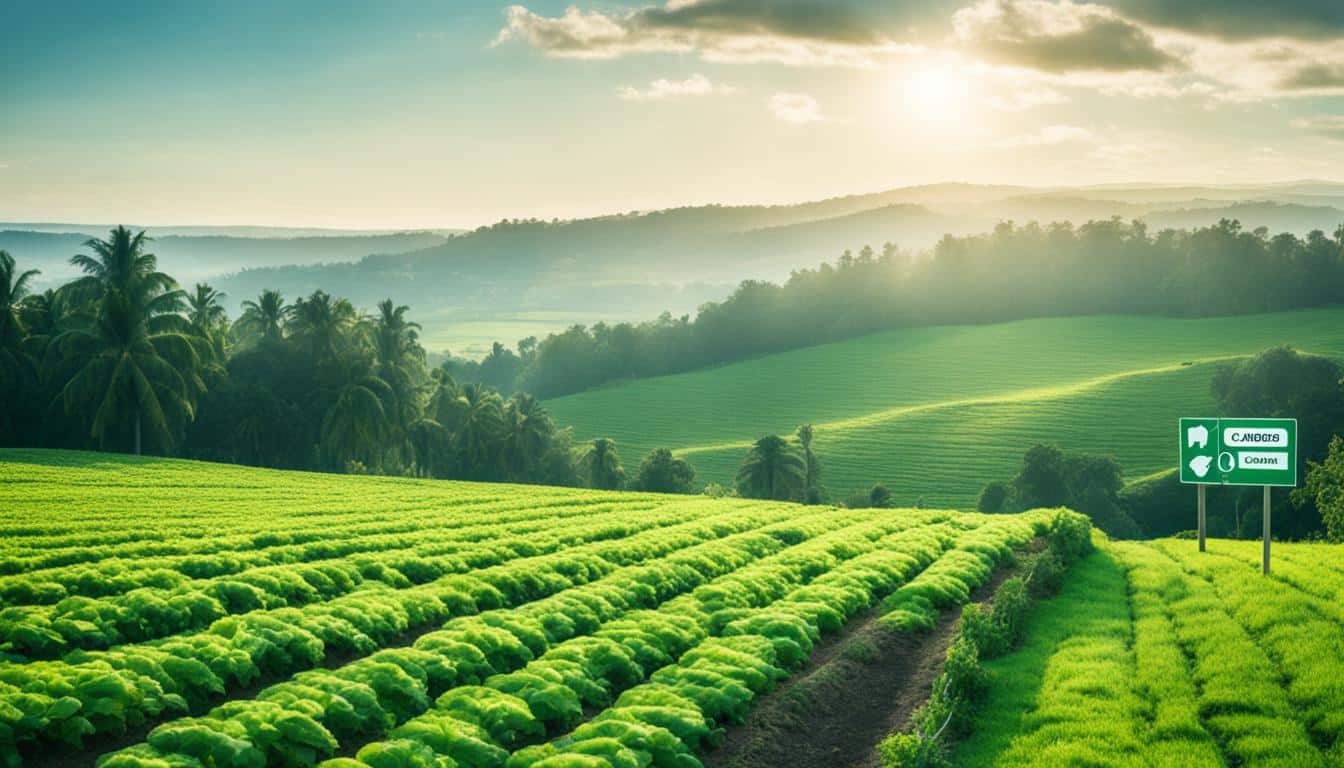
Did you know farming can hold three times more carbon than the atmosphere does? Carbon offset programmes in farming are becoming crucial for greener agriculture. These programmes focus on actions that stop the release of harmful gases. They then offer ‘carbon credits’ that work in cap and trade systems. Each credit means one less ton of harmful carbon dioxide in the air.
The US doesn’t yet have a nationwide cap and trade system. But, California is leading with its own successful version. Techniques like using certain crops each year, planting cover crops, and avoiding ploughing can radically boost farming’s carbon storage. Those participating include the farmers, experts who help manage the carbon credits, checkers making sure claims are true, and buyers.
Although many companies are stepping into carbon offset markets, there are still big challenges. The main ones are how hard it is to work with the market and to check if things are really being done. People wonder if these markets are truly effective and worth it. This means we need to keep working on making things better.
Carbon offset programmes in agriculture are a great way to fight climate change. They move farming from producing greenhouse gases to absorbing them. They make carbon credits, each equal to removing or avoiding one ton of carbon dioxide. This is done by efforts to reduce emissions and protect the environment.
Farming certain crops and keeping the land covered helps store more carbon in the soil. This is important because soils can hold much more carbon than the air. Ploughing the land the old-fashioned way, however, can actually release more carbon.
In the world of agricultural carbon trading, there are several key groups. Farmers start the process, while brokers help sell the carbon credits. There are also independent verifiers who make sure the carbon is really being stored. And, of course, buyers who want to reduce their carbon footprint. Initiatives like California’s cap-and-trade program show that state efforts can make a big difference.
Two big ideas, additionality and permanence, are crucial for real carbon offset success. Additionality means the carbon storage wouldn’t have happened without the offset. Permanence ensures the stored carbon stays locked away.
More and more, businesses are paying farmers to offset their carbon. This shift is making the farming industry greener. It doesn’t just help with carbon but also improves the environment’s health, thanks to farming practices.
To understand green farming schemes, you must know what carbon offsets and credits are. They are invisible things showing one ton of carbon dioxide less in the air. This can also be another greenhouse gas.
Carbon offsets work by letting people or companies invest in projects that reduce their emissions. Through a market of carbon credits, each credit can stand for a ton of reduced emissions. Green farming methods like no-till farming and cover crops are key here. They keep more carbon in the soil, helping lower emissions.
In farming, green activities can lessen carbon footprints. Actions like:
Over the past two centuries, farming has added about 100 billion tons of CO2 to the air. This shows the urgent need for carbon offsets in this field.
Cap and trade is a system to control greenhouse gas releases. Here, businesses are given carbon credits to manage their emissions. While the United States lacks a national cap and trade, California is a good example. Its system does well to lower emission limits over time, pushing for greener and cleaner practices.
Many businesses buy carbon credits to offset their pollution. They fund eco-projects and thus encourage green farming. In this carbon market, you’ll find farmers, checkers, and credit organisers. They make sure carbon storage is done right, using high-tech tools like models, satellites, and ground testing.
“Through regenerative farming, farmers can change from adding to greenhouse gases to trapping them,” said a top climate expert. This change is great for the earth and can also make money by selling carbon credits.
Agriculture can greatly help reduce climate change through farming methods. It is responsible for 11% of the world’s greenhouse gases. Livestock farming is the biggest part. Still, the sector can help create a better future by storing carbon.
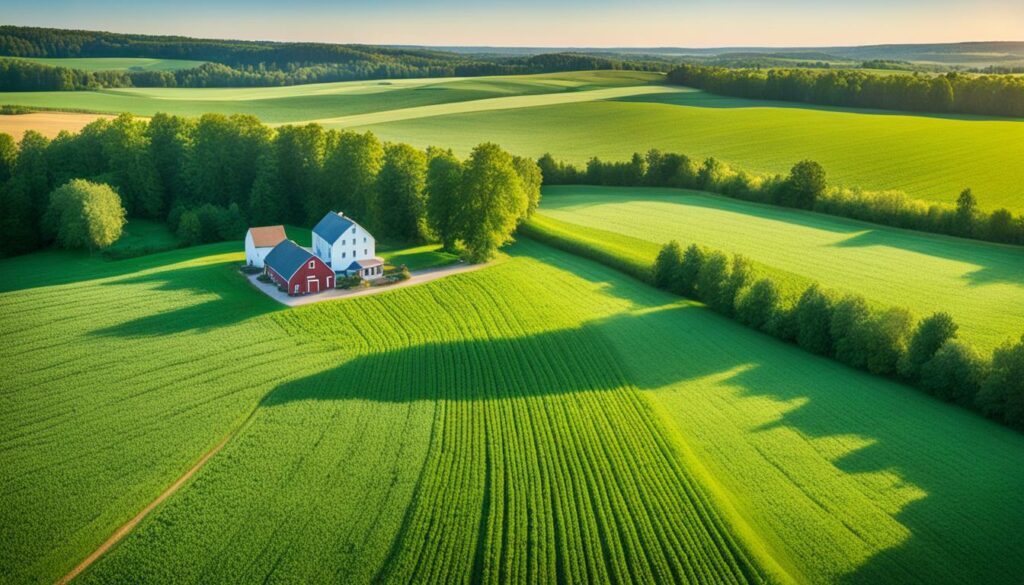
Farming has released more than 100 billion metric tons of CO2 into the air in the last 200 years. This is a lot more than all human activities in 2019. To lower CO2 levels, projects that pay farmers for storing carbon have become essential. Cargill’s Soil and Water Outcomes Fund, for example, offers farmers $30 to $45 for each acre, helping to lock away around 7,500 tons of CO2.
No-till farming is a great way to store carbon. It cuts down on nitrous oxide emissions a lot. Compared to traditional tilling, it lowers emissions by 57%. This is important because N2O warms the planet almost 300 times more than CO2 does. Using no-till farming with cover crops improves soil health and stores more carbon.
In North America, agriculture can supply 326 million tons of carbon credits every year. But the demand is for 190 million tons. The value for these credits is around $5.2 billion. This shows there are big financial rewards for farmers who join carbon markets.
| Year | Carbon Sequestered (tons CO2 equivalent) | Total Revenue from Carbon Credits (US$) |
|---|---|---|
| 2019 | 40-60 million | $30,000-$45,000 per acre |
| 2020 | 55-75 million | $35,000-$50,000 per acre |
| 2021 | 60-85 million | $40,000-$55,000 per acre |
Carbon credits can be worth between $5 and $60 per ton of CO2 equivalent. In places like Iowa, large farming projects can earn $30,000 to $45,000 per year. They do this by selling 2-3 credits per acre. This can store 40-60 million metric tons of CO2.
As we look at how farming can both produce and store carbon, it’s clear that storing carbon is key to reducing CO2. With the right support and methods, farming could shift from making the environment worse to actively helping. This brings benefits for our planet and for the farmers’ incomes.
The agricultural carbon credit market is full of life, with many people involved. These folks help create, check, and sell carbon credits. I’ll explain the main roles in the market and how they boost carbon trading in farming.
Farmers and landowners lead the way in the carbon credit market. They use methods like no-till farming and planting cover crops to trap more carbon. Indigo Carbon is a key player, paying farmers between $30 and $40 per credit in 2022. Farmers kept 75% of the sale if they shared their sustainable farming records from the past 3-5 years.
These intermediaries, like Indigo Carbon and TruCarbon by TruTerra, gather carbon credits from many farmers. Together, they make a big, sellable package. TruCarbon’s latest payment rates were between $15 and $30 per ton of new carbon kept in 2022. The farmers who sign up have to report for 20 years.
Verifiers are essential. They make sure the carbon credits are real by using things like computer models and sampling. Buyers, often working towards green aims, purchase these credits to make up for their CO2 output. A standout is Nori, offering a special program and always receiving new credits. The Bayer Carbon Initiative is also a big player now, showing more interest from different sectors.
| Key Players | Roles and Examples |
|---|---|
| Farmers and Landowners | No-till farming, cover crops. Example: Indigo Carbon farmers earn $30-$40 per credit. |
| Credit Aggregators/Brokers | Bundle multiple credits. Example: TruCarbon by TruTerra offers $15-$30 per ton. |
| Verifiers | Validate carbon sequestration. Methods: Satellite imagery, soil sampling. |
| Purchasers | Buy credits to offset emissions. Example: Nori’s 1:1 exchange rate. |
Choosing sustainable ways in farming guides farmers to join carbon offset programmes. These practices include sustainable harvesting and regenerative farming. They boost soil health and make farming more resilient and eco-friendly.
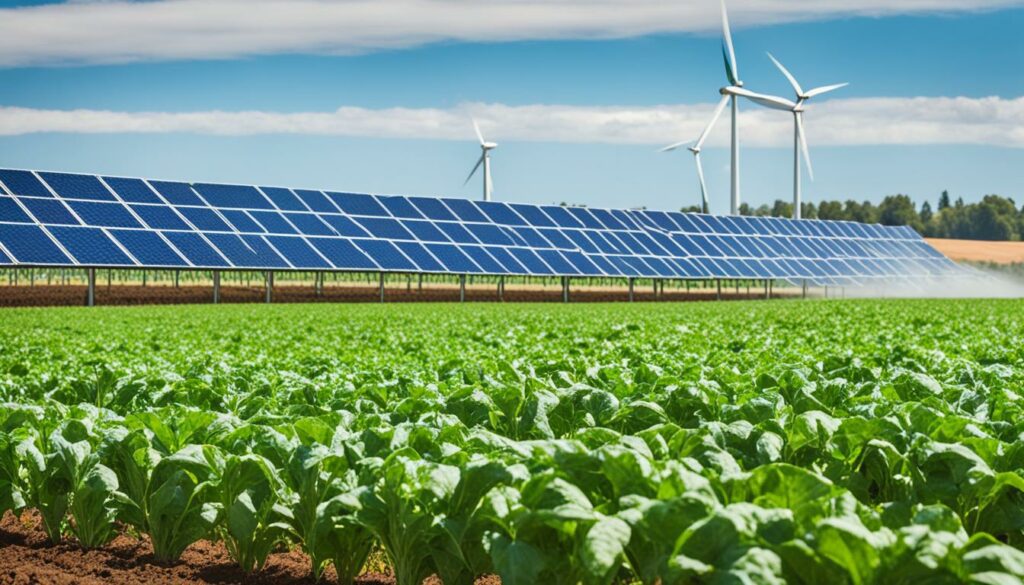
No-till farming means not ploughing the soil, keeping the stored carbon safe. Over 100 billion metric tons of CO2 have been released in the past 200 years due to farming. No-till farming cuts down N2O emissions by 57% compared to traditional methods.
This is key for sustainable farming because it improves soil while lessening greenhouse gas emissions.
Cover crops are grown between main crops. They improve soil, add organic matter, and soak up carbon. As these plants break down, they help the soil store more carbon.
Research shows that using cover crops can turn farms into places that take in carbon. This lets farmers sell carbon credits in carbon markets.
Perennial crops last for years and have deep roots. They store more carbon than crops replanted each year.
By keeping soil rich and healthy, perennial crops support long-term sustainability in farming. Companies like Cargill and Microsoft buy carbon credits from farmers who grow perennial crops. This helps support farming practices that are good for the earth.
| Practice | Benefit | Environmental Impact |
|---|---|---|
| No-Till Farming | Improved soil health | Reduces N2O emissions by 57% |
| Cover Crops | Enhances soil structure | Increases carbon absorption |
| Perennial Crops | Deep root systems | Sequesters more carbon over time |
Farming can have big effects on the environment, so it’s important to find ways to lower these impacts. One big method is using conservation tillage. This way of farming helps keep the soil healthy and cuts down on carbon emissions. Farmers see less pollution and better land use when they use this method.
Reducing excess nutrients in the soil is also key. Nutrient management methods, like testing plants and using fertilisers wisely, help cut down on harmful emissions. This isn’t only good for the planet. It also makes sure that crops grow well and the soil stays fertile.
We can’t forget about methane from animals in farming. Technologies like anaerobic digesters can catch methane from manure and turn it into something useful. Changing what animals eat can help lower methane too. This makes dairy and meat more sustainable.
It’s not just about the methods farmers use. Joining cap-and-trade markets lets farmers earn through good practices. They can get money from trading carbon credits. This way, farmers can make more money while protecting the environment.
| Strategy | Description | Impact |
|---|---|---|
| Conservation Tillage | Minimises soil disturbance and retains carbon in the soil. | Reduces carbon emissions and improves soil health. |
| Nutrient Management | Precision application of fertilisers and plant tissue testing. | Reduces nitrous oxide emissions and enhances crop yield. |
| Methane Capture in Livestock | Installation of anaerobic digesters to trap methane from manure. | Converts emissions into energy, reducing overall greenhouse gases. |
| Cap-and-Trade Participation | Engaging in carbon credit trading through sustainable farming practices. | Offers additional revenue and promotes environmental conservation. |
To sum up, using smart farming methods along with cap-and-trade helps a lot. These approaches lower emissions and make farming sustainable. They protect the planet and help farms be more efficient and successful.
Reducing the environmental impact of farming is crucial. Carbon offsets are key to this effort. They help decrease the 11% of global emissions that come from farm activities, mainly from raising livestock. This approach lets the farming sector aid nature’s preservation and fight climate change by offsetting greenhouse gases.
Carbon trading’s good is more than cutting emissions. It boosts soil health, keeps wildlife habitat safe, and limits water pollution. The EU Emissions Trading System significantly cut EU emissions by 350 million tCO2e. In California, companies used over 200 million metric tons of carbon offsets by 2020, thanks to a cap-and-trade scheme. Such cases show how carbon trading can bring big, visible benefits for our planet.
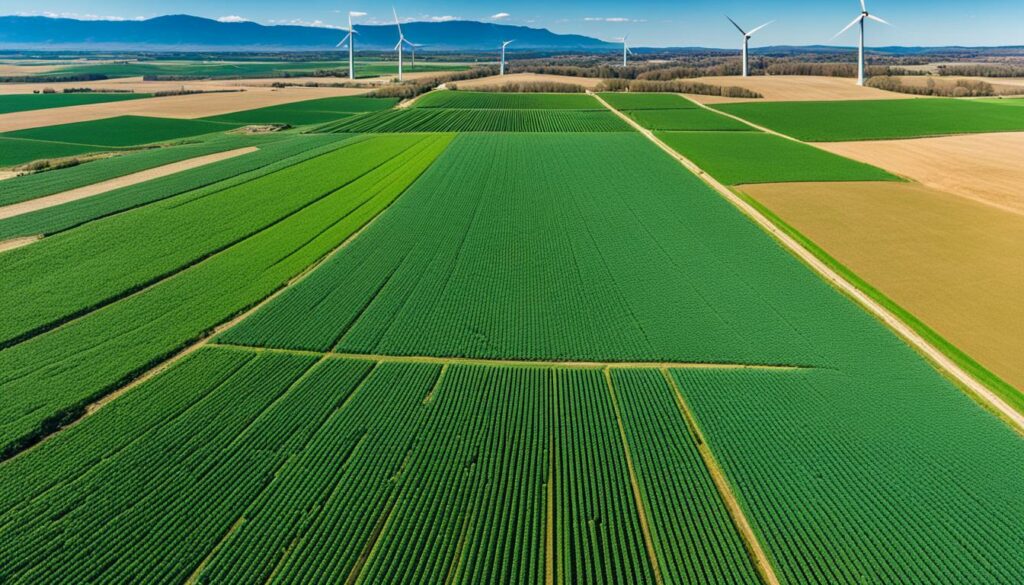
The financial side of this is very important too. In North America, the market for farming’s carbon credits is worth $5.2 billion. Prices vary from $5 to $60 per ton of CO2 removed. The food and drink industry drives a lot of this demand. For example, Indigo Ag aims to help eliminate one trillion tons of CO2 from our skies. This shows the industry’s significant efforts.
It’s great to see efforts like Cargill’s Soil and Water Outcomes Fund. They pay farmers for each ton of CO2 their land removes. This model not only motivates farmers to go green. It also pays them fairly for their eco-friendly work.
The US Congress’ “Growing Climate Solutions Act” is also a breakthrough. It aims to help farmers earn from looking after the land. This legislation lines up with the USDA’s target to cut farm carbon footprints by 40% by 2050. It offers a solid plan for making farming greener.
To end, carbon offsets are vital in cutting farming’s environmental harm. By using carbon trading, the farming world can find a sustainable mix. It supports environmental health and economic success together.
In the push for climate-friendly farming, using eco-farming ways is key. Two big methods are biological pest control and agroforestry practices. They help farming be more sustainable, boost plant and animal variety, and toughen farming against threats.
Using natural predators instead of chemical sprays is a strong choice. This method involves natural enemies to keep the pest population in check. It helps balance the ecosystem and lowers any harmful effects on the environment. This way, farmers can improve their crops safely, looking after the land and water.
Agroforestry does more than just suck up carbon. It adds trees and shrubs to farmland to stop the soil washing away and to support more wildlife. The mix of crops and trees makes a better home for many plants and animals. Moreover, the trees and shrubs trap a lot of carbon, working towards farming that’s better for the planet.
Both using natural predators and mixing trees in with crops are vital for lasting farming. They cut down on harmful chemicals and make nature work better. This leads to farming that’s not just healthier but also stronger against future challenges. It’s all about moving towards farming without adding harmful stuff to our environment.
Farmers find big benefits in joining carbon offset programmes. These mix good for the planet with earning money. Such schemes offer farmers carbon credit revenue for using eco-friendly methods like no-till farming, cover cropping, and better managing nutrients.
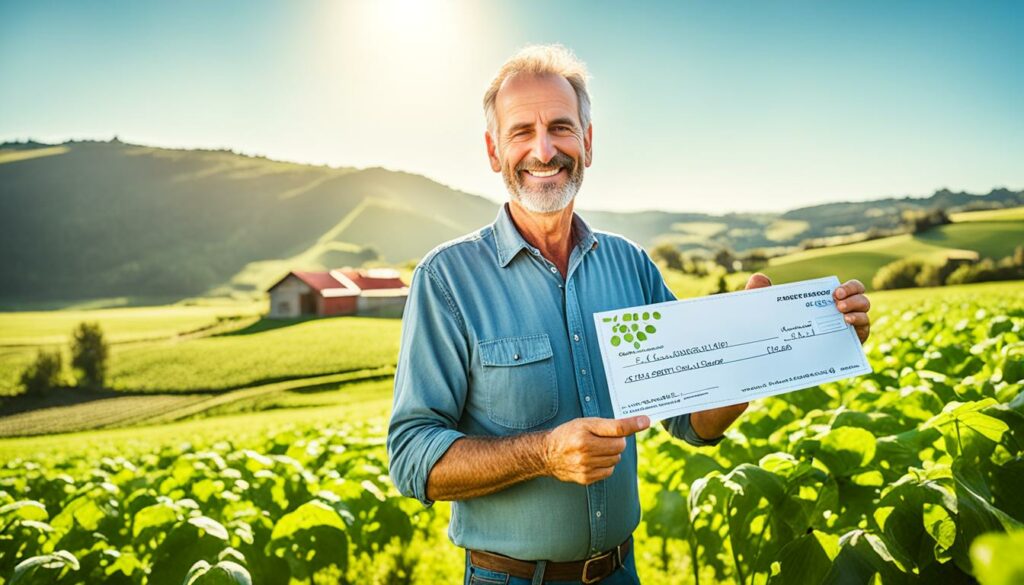
By using these methods, farmers get extra cash. They can make money from their eco-friendly work. This happens because they’re paid about $15 for every ton of carbon dioxide they save.
This payment helps a lot. It’s even more helpful now that saving carbon is worth even more money. It’s expected to jump to $70 or more for every ton saved.
A lot of different people work together to make sure this system runs smoothly. By working as a team, they help farms make more money. This keeps rural areas financially strong for the long haul.
Both big and small companies getting involved show carbon offsets are a valuable idea. It’s an extra bonus for farmers going green. This helps cut down on the harm farming does to the environment. It also adds to a farm’s income, helping it do better overall.
Getting money for these efforts is important to stop climate change. To reach this goal, about 22% of farmland needs to change. This means switching to methods that lock up carbon or carbon farming.
Tools like computer models, pictures from space, and testing the soil make sure these steps are real. This keeps the system honest and makes sure the money goes where it should.
Farmers can really benefit from these schemes. They help farms work better and support the fight against climate change. It’s a win-win for everyone.
Setting up carbon offset schemes in farming poses many challenges. It’s tough for farmers to get involved due to various hurdles. One major problem is the money needed to start. Switching to new farming methods and checking if they work costs a lot. Though, these projects can pay off. For example, by doing these projects, farmers can make about $30 for each acre they farm. But, for this to really work well, the price of the carbon credits from these projects must be more than $30 for each metric ton of carbon they save.
The carbon market itself is also very complex. Farmers have to learn how to make and trade their carbon credits. And it’s getting more complicated because of new rules like the Growing Climate Solutions Act. This makes it hard for them to take part effectively.
Proving that their projects really help the environment adds another challenge. Farmers must carefully watch and measure the gases their farms produce. This job is difficult and can cost a lot. The U.S. Department of Agriculture is spending $300 million to help improve this process. Yet, this shows how much it takes to meet the rules for these projects.
Getting help from experts and others can make things easier. The USDA is working on programs to help smaller farmers and forest owners join in. This shows the need for everyone to have a fair chance to be part of these markets. Making things simpler and trying to lower the costs can make these programs more open to all.
Despite all these issues, carbon projects in farming can do a lot for the environment. For example, if all U.S. croplands became no-till, they could trap over 100 million metric tons of carbon every year. This is the same as removing 11 million cars off the road each year. To achieve this, we must help farmers by giving them the right education, incentives, and support. Doing so is key to unlocking these benefits and making agriculture more sustainable.
Carbon offset programmes have two main types of markets: voluntary and compliance. Voluntary schemes let companies and people balance their emissions without being told to. This promotes looking after the environment through choice. Compliance markets, however, are guided by laws. They make companies follow strict emission rules and trade credits to meet these rules.
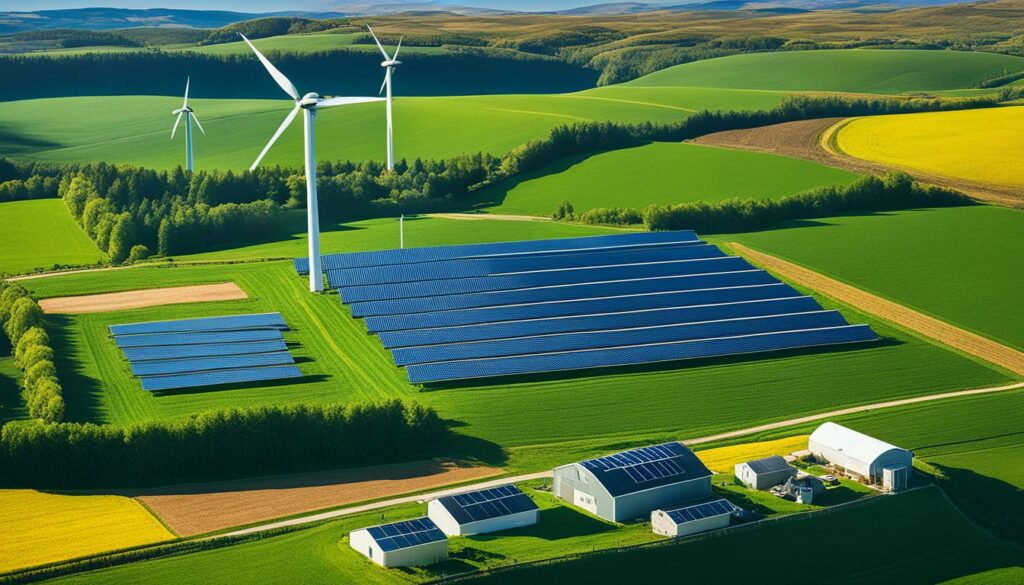
In the US, carbon offset programmes follow a variety of rules. In places like California, a cap-and-trade system is in place. This system sets a limit on greenhouse gas emissions. It also allows the trading of emission rights for compliance. These models show how compliance carbon markets can be used to tackle environmental issues and enforce carbon offset rules.
Voluntary carbon actions, like those by Persefoni and Patch’s Zero-Commission Carbon Offset Marketplace from 2021, are open to everyone. Without the need for laws, these markets support projects like biomass and protecting the oceans. Even though they’re not forced, they help boost a company’s image and commitment to the planet.
Compliance markets, on the other hand, are strictly controlled. For instance, the Regional Greenhouse Gas Initiative (RGGI) started in 2005 and includes states such as New York and Virginia. Under the RGGI, companies can use certain offsets for a part of their compliance, but only if they meet strict checks on cutting emissions. These rules make sure their promises to reduce emissions are kept, which in turn has a big effect on fighting climate change.
The rules behind carbon offset schemes in the US are varied yet changing. Some places, like California, and efforts, like the Natural Capital Exchange (NCX), show how effective compliance markets can be. Other areas might still be voluntary. Canada started a GHG Offset Credit System in 2022. This effort focuses on capturing methane from landfills, with plans for more ways to offset emissions. These new guidelines show the many ways to deal with greenhouse gases, especially in farming and other sectors.
It’s vital to know the difference between voluntary and compliance markets if you are involved in carbon offset work. Each market type has its own way of supporting the environment. By understanding these differences, we can find better ways to reduce harmful emissions.
Offsetting the farming carbon footprint reduces greenhouse gas emissions. This involves using strategic methods to cut down emissions from farms. Farmers can improve sustainable farming greenhouse gas mitigation through various approaches. These methods help them utilise the potential of agriculture to offset carbon.
One important way is to use new methods for crops and animals. No-till farming, for example, means farmers don’t disturb the soil. This not only lowers the release of carbon but also decreases nitrous oxide by 57% compared to older methods. Adding cover crops can also help. These crops make the soil better and keep more carbon in it. The ground can hold three times more carbon than the air. This shows how much carbon can be stored by the soil.
Also, high-tech tools like computer models and satellite pictures can check how much carbon is saved. Using such technology makes carbon credits more trustworthy. As a result, farmers can sell these carbon offsets to help meet global emission targets.
Today, reducing the carbon footprint from farming is very important. Big companies like Microsoft, Cargill, and Shopify are helping. They buy carbon credits from farmers. This not only boosts the farmers’ income but also supports green farming and cuts greenhouse gases.
Using sustainable land management methods is key for better farming and fighting climate change. These ways help crops grow better and keep more carbon in the soil. This leads to a healthier planet.
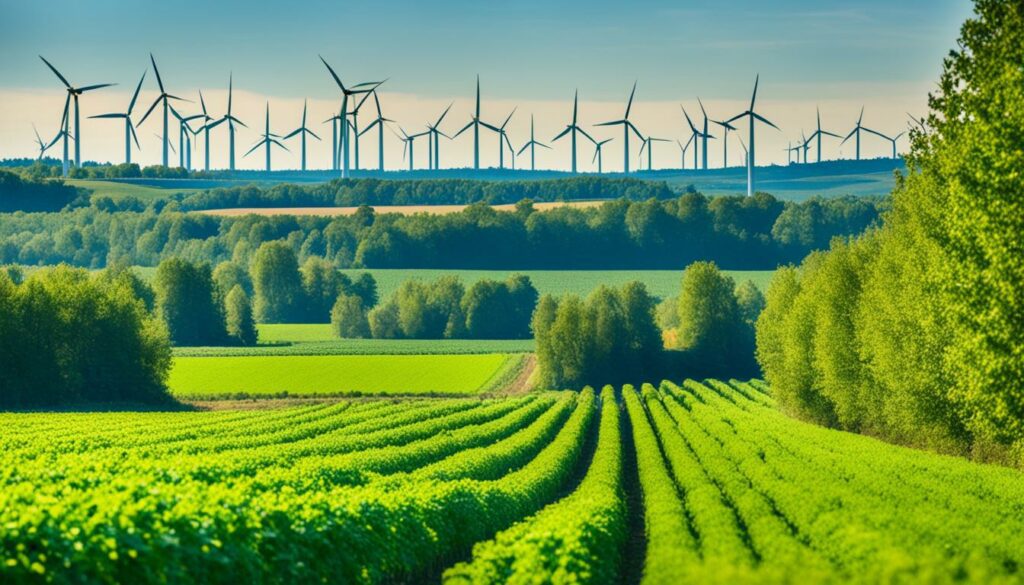
Crop rotation is vital for sustainable farming. It means planting different crops in the same field each year. This stops pests, reduces sickness in the soil, and makes the soil healthier. All this makes farming stronger and more earth-friendly.
Integrated Pest Management (IPM) is a full approach to pest control. It uses many ways to fight off pests, not just chemicals. This means it’s better for the environment.
By using these methods, we see many nature benefits. There’s more variety in wildlife, the soil gets better, and we keep more carbon in the ground. The right mix of these methods can make farming very sustainable.
Below is a comparative table illustrating key benefits of crop rotation and IPM in sustainable land management:
| Strategy | Key Benefits |
|---|---|
| Crop Rotation |
|
| Integrated Pest Management |
|
For the past 200 years, farming has let out more than 100 billion metric tons of CO2. This is more than human activities in 2019. To fix this, we need to use methods that capture carbon. These include improving how we store carbon in soil, planting trees in fields, and using farming methods that are good for the environment.
No-till farming is a great method. It has been proven to lower nitrous oxide (N2O) emissions by 57% compared to ploughing. Since each ton of N2O warms the earth 296 times more than a ton of CO2, cutting down on N2O is really important. No-till also improves the soil and helps more plants and animals thrive.
By growing extra crops and crops that last many years, we can keep more carbon in the soil. These extra crops are grown in between our main harvests. They add organic material to the soil, storing more carbon. Crops that last for years, like fruit trees, are especially good at storing carbon.
In Europe, areas that might turn into deserts can be saved by these farming methods. They stop the soil from wearing out and help keep farms healthy for the future. Also, planting trees and bushes on farmlands helps capture even more carbon. This makes farms places that take in more carbon than they give out. It’s great for fighting climate change.
Using these methods is good not just for the planet but for making money too. Farmers can sell the ‘carbon credits’ they earn. Big companies pay good money, up to $20 per ton, for these credits. Companies such as Cargill and Microsoft are already buying from these farmers. This gives farmers more reasons to farm in ways that are kind to our planet.
To make the world better, farms need to start following these new methods. By doing this, not only will our farms help the earth but they’ll also be stronger financially. This supports goals like the “Growing Climate Solution Act”. It also makes the farmland a healthier place for everyone.
So, by using these special methods, we can turn farms into a big help in the fight against climate change. This way, our farms can become a key player in lowering CO2 in the air. It’s all about using our land in ways that are good for the planet. And by doing so, we make sure our farms stay productive for a long time.
Getting involved in carbon offset programs in farming means you need to know about sustainable practices. This guide will show you how to start using farm carbon schemes. It will also cover the key points for creating and checking carbon credits.
Farmers thinking of trying a carbon offsetting framework should check if they’re eligible. This means seeing if their farming fits the rules for creating carbon credits. Actions like no-till farming and growing cover crops can make a big difference by trapping carbon and cutting down greenhouse gases.
After you check eligibility and start those green practices, it’s important to measure the carbon saved. This step involves figuring out how much CO2 your farm activities trap. You can do this with soil tests, space pictures, and special computer models. An example is how no-till farming reduces certain harmful emissions by a lot more than traditional methods.

Once you’ve figured out what you’re saving, the next step is proving it. Validation is key to making sure your carbon credits are real. Independent experts use specific methods to check if your efforts truly reduce emissions.
Knowing how the money and systems work is also very important. Sometimes, companies and governments pay for carbon credits. They usually cost between $15 and $20 for every ton of carbon saved. This system encourages farmers to keep up their green practices. There’s also a market for trading these credits, making it easier for everyone to get involved in reducing emissions.
Getting support from investors and big companies is crucial too. Companies like Cargill, JPMorgan Chase, Shopify, and Microsoft are stepping up. They’re buying carbon credits from farmers, which pushes eco-friendly farming on a larger scale. This support is vital for farmers working on implementing farm carbon schemes.
Everything is connected in the carbon offsetting process. Being eligible, measuring, proving, and knowing the financial side all work together. This helps farmers make a big difference in fighting climate change.
| Aspect | Detail |
|---|---|
| Eligibility | Alignment with sustainable farming practices |
| Quantification | Measuring CO2 sequestration via soil tests, satellite imagery |
| Verification | Independent validation of emissions reductions |
| Financial Aspects | Carbon credits priced $15-$20 per ton, supported by trading schemes |
| Support | Investors like Cargill, JPMorgan Chase, Shopify, Microsoft |
The future of carbon offset programmes in farming looks bright. Significant investments and policy actions are leading the way. President Biden has set aside $300 million to improve measuring and reporting on carbon emissions. This aims to support smart farming and forestry practices that help fight climate change.
The Inflation Reduction Act will put nearly $20 billion towards USDA’s conservation over five years. This will increase demand for carbon offset funding. But, challenges like high costs and low returns make it hard for farmers to join in. It’s important to remove these barriers to make carbon offsetting easier and more rewarding for farmers.
USDA is thinking about setting up the Greenhouse Gas Technical Assistance Provider and Third-Party Verifier Programme. This will provide better technical support to farmers, helping them engage in carbon markets. A new program will also help small forest owners enter the carbon markets, showing a push for fairness and inclusivity.
It’s vital that carbon offset transactions are scientifically proven. Having solid scientific evidence ensures that the environmental benefits claimed in these transactions are real. This helps build trust and allows these practices to grow and evolve over time.
The Biden-Harris Administration wants to change America’s food system. They’re focusing on local, fair food production and making sure everyone can access healthy food. Since 2017, carbon offset markets have been promoting soil carbon sequestration. This is leading to environmental and economic wins for farmers.
Companies like Nori and Indigo are key in making carbon offset projects happen, starting in 2017 and 2019. These companies have faced challenges, such as ensuring their projects truly add value and overcoming the complexity of getting offset credits. However, their work is valued at $5.2 billion and more and more farmers are getting involved, like 10,000 acres in Iowa, showing positive growth in the sector.
To provide a snapshot of where the market stands:
| Factor | Data |
|---|---|
| Total Investment | $300 million (Biden’s Agenda) |
| USDA Conservation Programs Funding | $20 billion |
| Market Valuation | $5.2 billion |
| Enrolled Farmland | 10,000 acres (Iowa Farmers) |
| Carbon Payments | $30-$45/acre |
Looking ahead, the journey for agricultural carbon markets is exciting and full of promise. With more investments, better policies, and new technologies, the path to a greener farming future is clear. Sustainability trends in farming are on the rise, thanks to these efforts, bringing about significant change in how we think and act towards agriculture and climate resilience.
Carbon offset programmes in farming show big promise for a green future. In the US, over half of cropland has embraced no-till farming and other conservation methods. This has led to capturing a significant amount of carbon in the soil. Thanks to these practices, we remove as much carbon as 11 million cars every year.
More farming lands using similar methods could lead to even better results. For example, we could capture even more carbon if the whole US farmlands practised no-till. This measure alone could offset 2% of the total CO2 the US produces yearly. However, the use of beneficial practices like cover cropping isn’t widespread. Yet, these nature-friendly methods could help tackle up to 20% of the carbon problem by 2050, aligning with global goals to keep the planet from warming too much.
The power of these actions extends beyond farm borders. Projects like reforestation in the Amazon and soil saving in the McCloud River area showcase how we can also benefit nature. From planting mangroves in India to preserving rainforests in the Congo, these different efforts store a lot of carbon. Their combined impact shines a light on carbon offset initiatives’ central role in securing a healthier planet for the long run. But, to make this happen, overcoming current obstacles and fully utilising the farming carbon market’s potential is key. This way, we can shape a future where agriculture truly champions Earth’s well-being and resilience against climate change.
Carbon offset programmes in farming aim to reduce greenhouse gases. Farmers can earn carbon credits by these practices. This makes farming more eco-friendly and supports sustainable agriculture.
Activities like no-till farming and planting cover crops create carbon credits. These methods trap carbon in the soil and lower farm emissions.
Agriculture stores carbon in soil and plants. Farming methods like cover crops enhance this, turning farmland into significant carbon stores.
Farmers, credit brokers, verifiers, and credit buyers are key. Farmers use eco-friendly methods to sell carbon credits to offset buyers.
No-till farming, cover crops, and perennial crops are good practices. They improve soil health, store more carbon, and cut farming’s carbon footprint.
Use conservation tillage, manage nutrients efficiently, and capture methane. These strategies cut emissions and make farms more sustainable.
They fight soil degradation, promote biodiversity, and clean water. Carbon offsets help address climate change by cutting greenhouse gas emissions.
Techniques like biological pest control and agroforestry are eco-friendly. They reduce pesticide use and add trees to farming for more biodiversity and carbon storage.
Farmers make money by selling carbon credits. It encourages the use of sustainable practices and adds to their income.
Farmers must understand complex markets and meet strict rules. Also, they can face hurdles to funding. Training and support are needed to help them succeed.
There are voluntary and government-regulated markets. California’s state system is a model. The US lacks a federal programme.
Improve crop and livestock management, use new technologies, and save resources. These practices lower emissions and make farming more effective and sustainable.
Crop rotation and pest management without chemicals are part of it. These practices help the soil, control pests, and store more carbon. This supports both the environment and farming.
Enhancing soil, using agroforestry, and increasing biodiversity are key. They pull CO2 from the air and keep it in farming areas, boosting carbon storage.
They should learn about the programmes and how to earn credits. Guidance is important for making the right choices.
Technology, policies, and market changes will grow these programmes. This can lead to more effective and widespread efforts for a sustainable future.